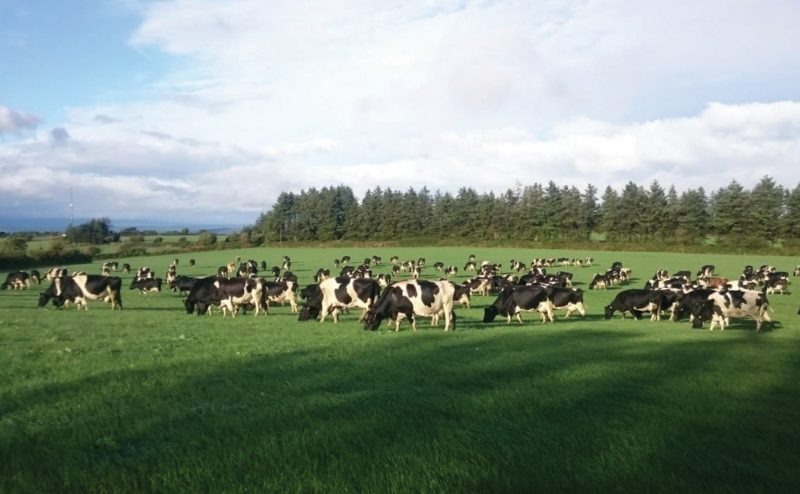
The Daniels family recently hosted the IHFA (Irish Holstein Friesian Association) Pure Friesian Club Open Day on their farm in Kilmoganny, Co. Kilkenny. The event, which was held on June 6, proved a resounding success for husband-and-wife Bryan and Gail Daniels who showcased their pedigree Friesian herd of 300 cows to breeders from all over the country.
The Raheenarran Herd is an outstanding spring calving herd backboned by Friesian breeding, making excellent use of grazed grass farming at almost 1,000 feet above sea level. The herd has expanded three-fold in recent years and former FBD Young Farmer of the Year Bryan isn’t ruling out further expansion in the event of extra land becoming available in the area.
The annual Glanbia Co-Op performance report showed the herd to be among the highest performing in the country. The top benchmarks achieved included: 422kg milk solids delivered per cow; 3.66% Protein (top 10%); 38.9 cent/litre milk price (top 10%); 365-day calving interval (top 10%): 90% six-week calving rate (top 5%); SCC 71 (top 5%).
“We’re constantly trying to get a higher efficiency within the herd,” says Bryan, who took over the family farm from his parents John and Charlotte when he was just 19.
“We’re dedicated to the success of the farm and attaining key annual benchmarks. We’re focused on breeding high-quality Friesian heifers and rear enough each year to have a 22% replacement rate for the herd. We’re able to pick the very best of the herd and sell the rest to repeat customers when they’re between six and eight weeks old. Also adding to stock sales and boosting income is the sale of four-to-five pedigree registered bulls for breeding each year.
“We have a good, hard-working herd which has been increased from 90 to 300 since 2007. This has been made possible by purchasing quota and extra land. We farm about 400 acres now, 40% of which is owned by Gail and I and the rest of which is on long-term lease.
“It’s very much a grass-based farm. We measure grass weekly and graze 11 months of the year, weather-permitting. Because of the altitude here, we need a smaller animal. I think that the ideal cow for this farm is 75% pure Friesian and 25% Holstein and that is what we’re aiming for.”
After completing his Leaving Cert in Kilkenny College, Bryan attended Kildalton College where he achieved a Certificate in Agriculture and subsequently a Certificate in Farming. He had planned to gone on to do a Diploma in Dairying at Clonakilty Agricultural College, but instead returned to the family farm to help his parents and hasn’t looked back since.
“They pretty much handed over the full management of the farm to me,” he remembers.
“They have been a great support to me ever since and so too has Gail, who hails from Carnew in Co. Wicklow and who I met through Marca. We met in Germany after winning Leadership Awards and are now happily married with two young children, Shannon (three) and Toby (15 months).
“It wouldn’t have been possible for us to grow the herd or run this system without the people we lease the land from or the people that work for us. Andrew Doyle works for us full-time and is a brilliant herdsman. We also have Dairy Farm Management student Brian Greene, who is doing the same course as Andrew did in Moorepark. It’s a real team effort.”
On taking over the farm, Bryan immediately identified dairying as the enterprise to drive the best return and the Friesian cow as the best vessel to achieve this. “We cut back on the beef system we had and put the focus on dairying,” explains the 2007 Young Farmer of the Year, whose family have been supplying milk to Glanbia (formerly Avonmore) for many years.
The herd was graded up using the IHFA service with pedigree status achieved quickly thanks to the records maintained. The strength of cow families was evident from the outset and the power of maternal breeding generation after generation has allowed for herd expansion from within.
There has been considerable interest from AI organisations in the herd genetics. Raheenarran MEB Sochar (RHS) was the first bull to enter AI. Sired by Morbeker Bas, his evaluation now includes 1,029 Irish milking daughters in 372 herds. His dam Raheenarran Hylke Breda VG87 proved to be a popular attraction as a Bull mother. She scored EX92 for legs and feet and this functionality score captured her longevity, lasting in the herd for 14 lactations. In total, she produced over 6,000kg milk solids with Protein to 3.98%.
Her Blackisle Glenalbiy son BCG Sochar (RVJ) currently has over 4,000 Irish milking daughters and also has milking daughters recorded in Australia. The ability to last and inherent good fertility of the Friesian is such that herd empty rate is typically between 7-11% per year. This provides for a positive culling policy with up to 10% voluntary cull every year.
As already stated, herd performance is very strong with an average of 422kg on milk solids delivered last year, generating a return of 38.9 c/l for 3.66pc Protein. AI is used in the milking herd. Genomic testing is carried out on the top quartile every year to aid data-based breeding decisions.
To cater for their expanding herd, the Daniels’ invested in a new DeLaval 44-unit rotary milking parlour in 2016. The picturesque farm is located just outside the village of Kilmoganny, which is 15 minutes from the M9 motorway via Junction 10.
Bryan and Gail Daniels
(Raheenarran Herd)
Raheenarran,
Kilmoganny,
Co. Kilkenny.
Telephone: 087 6663806
Email: [email protected]
Taken from Irish Tractor & Agri magazine Vol 6 No 6, September/October 2018